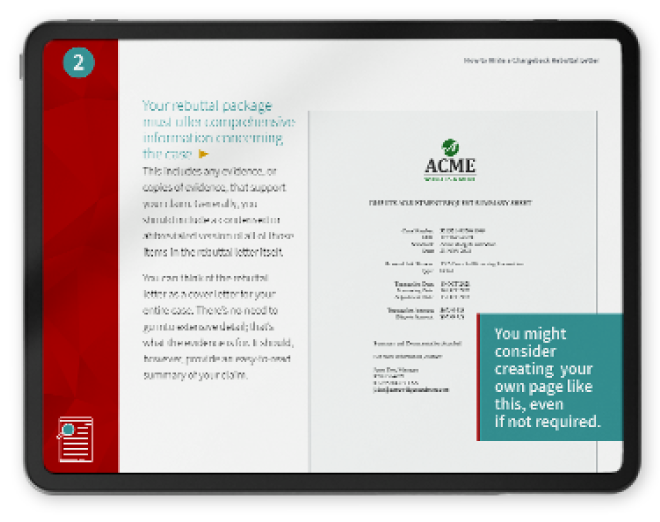What is a Chargeback Rebuttal Letter? Here’s Everything Merchants Need to Know
Cardholders have the right to dispute any charge they feel is incorrect or unfair. This is guaranteed by both card network rules, as well as federal law.
Sometimes, however, the payment in question is perfectly valid. According to Visa, first-party misuse of the process can account for up to 75% of all chargebacks. When a cardholder disputes a valid charge, the best course of action for merchants is to respond via a process called representment. A key component of this is the credit card chargeback rebuttal letter.
You’ll need a strong rebuttal letter if you hope to get the chargeback reversed. Here, we’ll explain what you letter must include, and offer key tips and templates to successfully challenge a payment card chargeback.
Recommended reading
- What is Compelling Evidence? Examples & Tips to Win Disputes
- Pre-Arbitration Chargeback Process: How do Pre-Arbs Work?
- Chargeback Reversal: 6 Simple Steps to Get Your Money Back
- How to Fight Chargebacks | Recover Revenue in 4 Basic Steps
- Maximize Your Chargeback Win Rate: 5 Tips From the Experts
- Mastercard Chargeback Arbitration: What You Should Know
What Are Chargeback Rebuttal Letters?
- Chargeback Rebuttal Letter
A chargeback rebuttal letter is a well-written synopsis of a chargeback case that explains why the claim is invalid. This situation-specific letter is an integral component of a dispute response package, which also includes compelling evidence to support your case.
[noun]/charj • bak • rə • bəd • l • led • ər/
The chargeback process was created to protect consumers. More and more, however, cardholders are using the system to dispute valid transactions, a process called first-party misuse, or more commonly, friendly fraud.
In some cases, friendly fraud can be an innocent mistake. The cardholder didn’t understand the process and assumed that a chargeback was the same thing as a refund. Other times, a customer may deliberately abuse the process to engage in “cyber shoplifting.” The good news is that, in either case, it’s possible to undo some of the damage done through the representment process.
Learn more about chargeback representmentYou can think of representment like a court case. The issuing bank is the jury, and the rebuttal letter outlines the case you’re making to the jury, arguing why you’re innocent of the charge against you. The rebuttal letter is a written statement that’s meant to give context for the evidence you submit. It explains, in simple and direct terms, how the evidence disproves the cardholder’s claim.
Crafting a rebuttal letter will be necessary to challenge a chargeback. While you should never try to contest a valid chargeback, experts recommend contesting all illegitimate claims, regardless of the cardholder’s motivation.
While the two terms are sometimes used interchangeably, it’s important to note that your rebuttal letter is just one part of your dispute response. For representment, you’ll need to include other supplementary material, as well as compelling evidence, to support your claim.
Why Do I Need a Chargeback Rebuttal Letter?
Solid evidence is the most important part of your chargeback response. But, your rebuttal letter if where you give your documents context, and explain why you reject the cardholder’s claim.
Let’s say a cardholder disputes a charge on their monthly statement. The issuing bank must first review and approve the claim based on a set of allowable chargeback reasons. The chargeback is then forwarded to your acquiring bank, who debits your account and notifies you.
At one point, the information would’ve come to you in the form of a Chargeback Debit Advice Letter. However, this practice has fallen out of favor with many institutions.
When you receive your notification, you have two options:
- Accept the chargeback
- Challenge the chargeback through representment
If you choose not to fight, you’ll lose the revenue from the sale, any merchandise shipped, and overhead costs like shipping and interchange. You’ll also be hit with a chargeback fee.
If you decide to challenge the chargeback, you’ll need to create a dispute response package. To make things more confusing, the response package is sometimes simply called a rebuttal.
The cornerstone of your response package will be your chargeback rebuttal letter. It should clearly state why the cardholder’s claim is unwarranted, and offer evidence to support your case. Think of it as a cover letter containing an overview of the important information the reader will find in your response.
What Should My Chargeback Rebuttal Include?
To write effective chargeback rebuttal letters, it helps to understand everything that should be included in your dispute rebuttal package. If you received a Chargeback Advice letter, it may give you case-specific requirements. Generally speaking, though, some or all of the following information will typically be needed:
- The chargeback reason code
- The transaction amount and the chargeback amount
- The action(s) already completed by the acquirer
- The deadline for submitting representment documents
- The adjustment date
- The case number assigned to the chargeback
- The cardholder number (or credit card number) used for the transaction
- The 23 digit identification (or reference) number assigned by the card network
That's a lot of information, and the list is not definitive. What’s necessary to contest a given chargeback will vary based on many factors, including the card network, the bank, or the reason code. Your chargeback advice letter or other notice from your acquirer will usually lay out all the required documentation.
As we mentioned, however, the key element of your dispute response is your rebuttal letter itself.

How to Write a Chargeback Rebuttal Letter
Now that we’ve covered the rebuttal package, let’s look at what the letter itself should contain. The goal here is to provide all the data necessary to prove your case, presented in the clearest, most easily understood format. That includes:
You’re dead in the water if the transaction and the challenge can’t be connected back to you. Provide the name of your business, your merchant identification number (MID), the reason code, and the case number of your challenge. Basically, any information that lets the bank know whose case it is. It may help to add context, such as what type of merchant you are, what you sell, and the channels you use for selling.
Succinctly talk about the transaction, the cardholder who filed the dispute, and the reason code the chargeback was filed under. State the total amount of the transaction, and what service or merchandise was involved.
Counter the cardholder’s claim as clearly and concisely as possible. Explain why the original transaction was valid. Your letter should be a high-level list of the evidence in your dispute response package. Since the actual evidence is included, there’s no need for great detail, though.
What you are asking for here — a reversal — should be obvious. That said, it never hurts to formally state what you want to happen.
Anger and indignation – no matter how justified – has no place in your rebuttal letter. Particularly if you feel a customer is trying to scam you, it’s really easy to get overly emotional. Leave your emotions out of it, though, and stick to the facts.
When you’re crafting your credit card chargeback rebuttal letter, focus on the Three Cs: Concise, Clear, and Compelling. We cannot stress this enough.
Write as much as you need to be easily understood, but make every word relevant. You want the bank to understand your position and rule in your favor. Anything that does not advance those goals should be edited out.
Sample Letters & Chargeback Rebuttal Templates
Looking for an example of a rebuttal letter? We’ve got one. Before we start looking at an example of a rebuttal letter, though, it’s important to understand that using generic form letters is a bad idea.
Our chargeback rebuttal letter template illustrates the general format to follow, and some of the elements that should always be included. Each representment case is unique, though, and should be treated as a distinct incident. You should customize the letter to fit the specifics of the case:
Download this sample Chargeback Rebuttal LetterThe credit card chargeback rebuttal letter is one of the first things a bank agent will look at after receiving your case. If a quick scan of your letter looks like something they have seen already in prior cases, they may not give it as much consideration as you’d like.
Your letter should be concise and simple, yet still unique enough so that investigators give it the diligence it demands.
Where Does Compelling Evidence Fit In?
In addition to your rebuttal letter, you need to provide evidence that backs up your claim. The evidence you should submit varies depending on the reason code attached to the dispute.
You can’t just say the customer’s dispute is invalid; the bank will want evidence to back up your claim. In most cases, the only one who can produce this evidence is you.
The documentation required for a given chargeback will depend on the reason code. In theory, the reason code will pinpoint why the cardholder is disputing the transaction. So, your evidence must directly address whatever reason code accompanied the initial dispute.
The true cause of a chargeback may be anything from a misunderstanding, to buyer's remorse, or even deliberate cardholder abuse. Nevertheless, the reason code represents what the bank considers the reason for the chargeback, meaning you must respond to the reason code in question.
Like other parts of the chargeback progress, the rules for evidence differ between card networks. Examples of what might be considered compelling evidence include:
- Sales receipt or order form
- Proof of delivery
- Cardhold signatures
- Customer email address, phone number, or IP address
- Photos or other documents suggesting the customer is satisfied with the purchase
- Proof the purchase was made by an authorized member of the cardholder's household
- Verification that the customer accepted Terms and Conditions
While this list represents several commonly requested items, it is hardly exhaustive. You’ll need to be very familiar with the chargeback regulations of all the major card networks to know what you’ll need to include.
Learn more about compelling evidenceTips for Writing a Chargeback Rebuttal Letter
While strong evidence will ultimately be what decides your case, your rebuttal letter underlines and clarifies how the facts support your challenge. Here are some things to remember when crafting a rebuttal letter:
Keep it Succinct
Be concise in your writing. Remember, your letter is just one of dozens the bank agent reads each day. Your letter should never be more than two pages in length.Keep it Simple
Make everything easy to scan and understand with good use of bullet points, short sentences, active verbs, and clear structure.Keep it Specific
Every rebuttal letter must be customized to the circumstances of the specific case. Cookie-cutter form letters or templates won't cut it.Keep Your Cool
Stick to the facts and don’t get emotional. Anger, annoyance, or frustration stemming from the cardholder’s claim have no place here.Keep it Timely
Each representation will come with a response time limit that will vary by reason code and issuer. Simply put, miss the deadline and you lose the case.
Keep it Complete
Your case is likely to get thrown out immediately without complete information. So, be sure to provide all the necessary transaction data.We’ve mentioned this repeatedly, but it’s worth stating again: your letter will probably be the first thing the bank agent looks at when reviewing the case. Strive for a good first impression.
For more details on how to create compelling and effective rebuttal letters, download the Chargeback Rebuttal Letter Guide for templates, advice, and a winning rebuttal checklist.
Rebuttal Letters: Part of a Larger Picture
The chargeback representment process itself is complicated, hard to understand, and subject to ongoing updates and revisions. The particulars for required evidence vary by card network and can change with no notice, so you must keep up with all changes and updates to card network rulesets.
Plus, individual parties — banks, card networks, processors, etc. — all have different guidelines and timelines. This makes your chargeback dispute response even more complex.
Sending wrong, incomplete, or misleading information with your chargeback rebuttal letter can do more harm than good. Even outsourcing the task can be risky if you partner with the wrong service provider. Some firms will address only the most obvious claims, while others simply send automated details that can damage your reputation with the issuer.
The right professional assistance ensures a higher net win rate without damaging your reputation or increasing risk. Chargebacks911® offers award-winning assistance with representment, rebuttal letter writing, and other post-transactional fraud needs. To find out more, contact us today.
FAQs
What is a chargeback rebuttal letter?
A chargeback rebuttal letter is a well-written, situation-specific document wherein a merchant explains why a chargeback claim is invalid. It is one component of a dispute response package, which also includes compelling evidence to support your case.
How do you write a rebuttal letter for a chargeback?
A chargeback rebuttal letter should convince the cardholder’s bank that the chargeback is invalid and should be reversed. A separate, unique chargeback rebuttal letter should be drafted for each transaction under dispute. Each letter should include identifying (i.e. merchant and cardholder) information, along with compelling evidence for why the chargeback in question was invalid.
What is an example of rebuttal response?
Your rebuttal response should include your contact information, an outline of the cardholder’s claim, your case and evidence outlining why the cardholder’s claim is false, and an explanation of your desired outcome. Click here to download a sample rebuttal letter template.
Should you write a rebuttal letter?
First you must decide if you have the necessary evidence to successfully counter the customer’s claim. If you decide to represent the claim, then yes, you will need to write a letter clearly explaining your position.
What is the purpose of writing a rebuttal?
The primary goal of the rebuttal letter is to provide an argument to the card issuer that the chargeback filed by the cardholder is invalid.
Does a rebuttal need evidence?
Yes. You’ll need to provide documentation showing that the transaction was valid and that the cardholder authorized the purchase. This could include a signed receipt, proof of delivery, or communication with the cardholder.
How do you respond to a chargeback dispute?
You can respond to a chargeback dispute by submitting a chargeback rebuttal letter as part of the representment process. A strong rebuttal letter, coupled with clear and convincing supporting evidence, can help you resolve disputes in your favor.
How do you fight a chargeback dispute?
You can fight a dispute by engaging in representment. Doing so gives you the opportunity to “re-present” a transaction, along with evidence that rebuts the cardholder’s claims. If you can successfully convince the issuer that you are in the right, you may be able to win the case and recover revenue associated with the disputed transaction.















